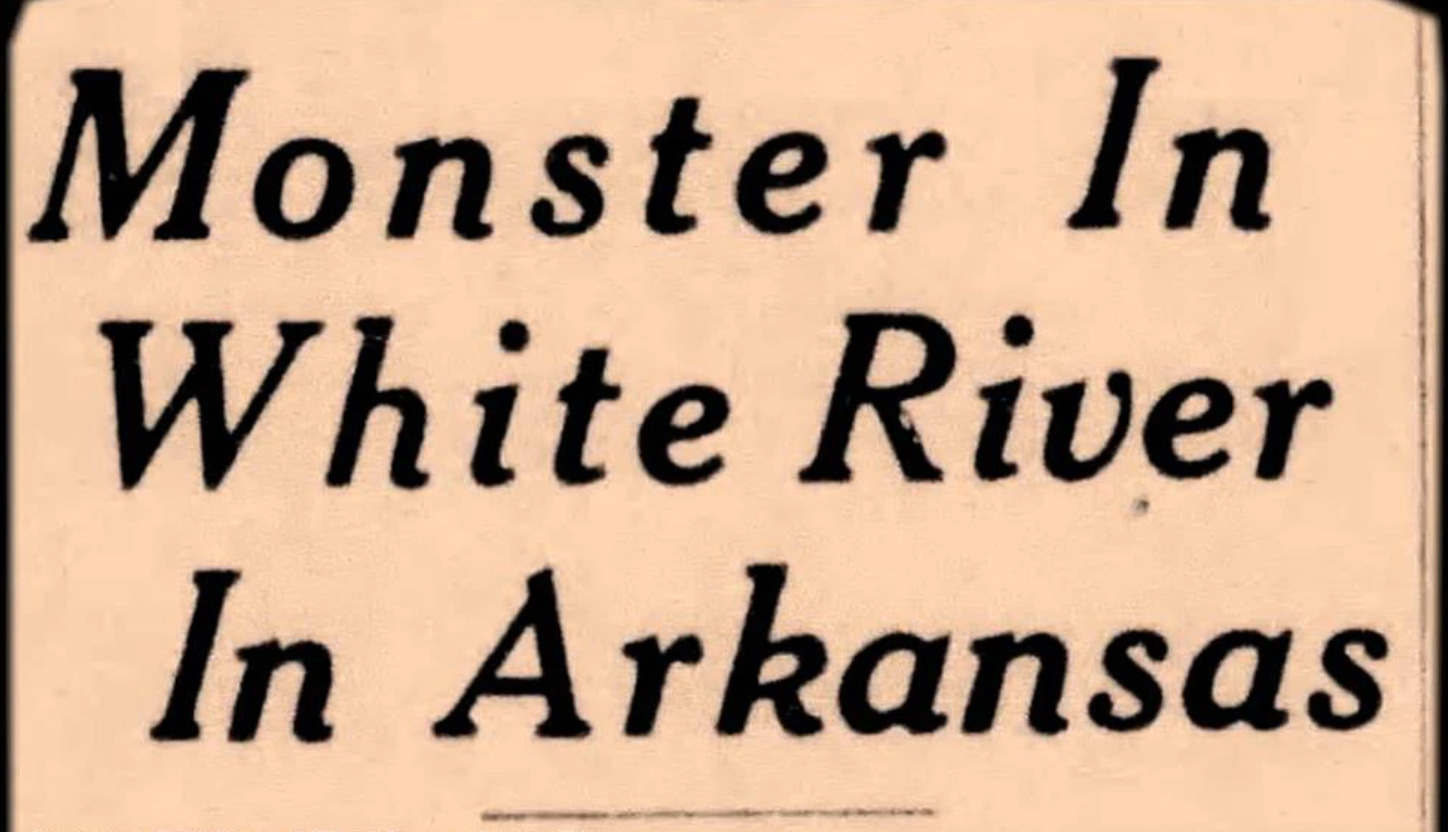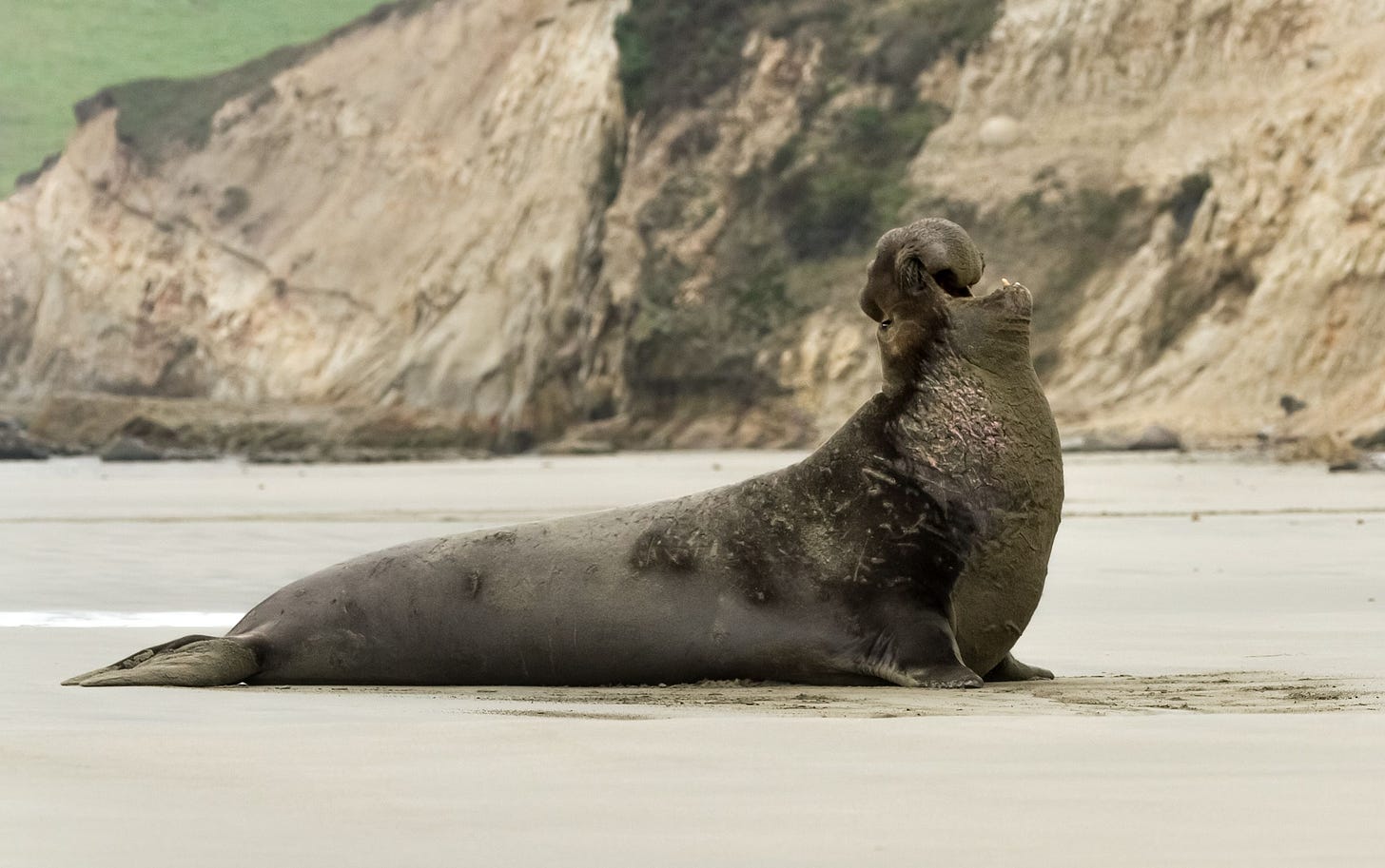Beware the White River Monster
The story of an Arkansas legend is wild, the (possible) truth even more so
Welcome to Flashlight & A Biscuit, my Saturday-morning Southern culture offshoot of my work at Yahoo Sports. If you’re just arriving for the first time, why not subscribe? It’s free and all.
Picture this in your mind: a creature with "the skin of an elephant, four or five feet wide by twelve feet long, with the face of a catfish,” “the size of a boxcar,” with skin peeling all over, a bone protruding from its forehead, and a call that sounds somewhere between “a cow's moo and a horse's neigh.”
A new college football mascot? The person who’s always sitting right behind you in a movie theater? Damn good eatin’? Maybe!
The story is a bizarre one. The truth — or something plausibly close to it — is even wilder.
Around here, we’re always down for a good tale of scary Southern monsters — cryptids, the cool kids call ‘em today — so now, in addition to past installments on South Carolina’s Lizard Man and Alabama’s Huggin’ Molly, we present the tale of the White River Monster of Arkansas. Please keep your arms, legs and other extremities inside the boat at all times.
The White River wobbles like a sleepy toddler through eastern Arkansas, cutting a north-south path not quite halfway between Little Rock and Memphis. It’s beautiful country, winding from the foothills of the Ozarks through old-growth forests and stop-sign towns until it finally hooks up with the Mississippi not far from Rosedale, Miss.1
It’s also remote territory, fertile ground for imagination to outrun observation. One day in 1915, a farmer — it’s always a farmer in these stories, isn’t it? — spotted a rough beast in the waters of the White River. The farmer wanted to capture the monster, and so did a bunch of compatriots, but once everybody sobered up and realized exactly what would be involved in snagging an enormous brute, folks lost interest.
The beast remained hidden for 22 years, until Bramlett Bateman, another farmer (see?) with a name like a University of Georgia quarterback, heard local fishermen complain that something was stealing their catches. Bateman, as would be expected from someone living in SEC country, decided to take care of the monster by just blowing up a section of the whole damn river.
Local authorities wisely denied Bateman the permit to start a-blastin’, so he pivoted to an entrepreneurial mindset and invited the nation in to hunt the beast. And the nation took the bait, albeit with a suspicious eye. According to Time magazine, “In Washington, the Bureau of Fisheries said it might be an alligator gar, which reputedly grows, sometimes, to be 20 ft. long. Other guesses: water-logged tree trunk, sunken barge, eruption of subterranean gases throwing up leaf accumulation, devil fish, sturgeon, or Old Blue, the legendary giant catfish of the Mississippi who every so often gets stuck in a canal lock or nudges in the bottom of a barge.” (Come on, Blue. Get it together.)
The federal gub’mint’s skepticism didn’t stop locals from lining the banks of the White River for impromptu “Monster Parties” to see if they could spot the beast. Between the news media, the apparently heavily-armed locals, and the deep-sea diver who hunted (fruitlessly) for the monster in the river’s depths — visibility: three inches — it’s a miracle that nobody died. Either way, the monster eluded capture or even observation.
Flash forward to the summer of 1971. Carole King’s “It’s Too Late” is the song of the season, and the White River Monster, perhaps lured by the sounds of expertly-crafted sentimental pop, resurfaces, much to the horror of whatever stoned teenagers happened to be hanging out on the riverside. That’s where the boxcar/bone/moo/neigh descriptions above came from, and that’s when marine biologists — and, uh, others, as we’ll see in a minute — were able to start getting a handle on what the monster might really be.
A couple years afterward, a local politician, keenly observing the direction of the wind, decided to hitch his wagon to ol’ WRM, declaring a stretch of the river to be the White River Monster Refuge. The Arkansas state legislature passed a law making it illegal to harm the White River Monster within the refuge, which is exactly the kind of useful efforts that politicians should have been focusing on in the very calm days of 1973.
Let’s get down to it. Half-truths and speculations and weird legislation aside…
…what exactly is the White River Monster, anyway?
What’s your favorite tale of the weird, mysterious and unexplainable, like monsters that go bump in the night or Nashville universities allowed to play in the SEC? Share, share:
I’ve spent enough time in Southern backwaters and/or inebriated in Southern climates to understand how the mind can play tricks on you, so I’m never surprised when some sort of fever-dream whiskey hallucination catches fire. But here’s what’s wild: it’s entirely possible that the White River Monster is real.
OK, not “drag wayward sailors down to their doom” real, but “yes, you can poke it with a stick” real.
Enter: the cryptozoologists.
Whatever your job may be, I guarantee it’s not as cool as getting paid to research weird, possibly mythical animals. These skeptics2 travel the world ferreting out the truths behind legends, and at least a couple of them have trained their suspicious eyes on the White River.
Professor Roy Mackal of the University of Chicago, who had a Ph.D. in biology but no apparent experience with zoology, decided that the White River Monster was an elephant seal, a big ol’ howling multi-ton hulk that would indeed scare the living hell out of you if you happened to see it in an Arkansas river:
But paranormal investigator Joe Nickell3 disagreed, contending instead that the White River Monster is a manatee. (Aw yeah, paranormal investigator fight! The History Channel salivates at the thought.) Nickell’s conclusion, which is fairly persuasive, is that elephant seals primarily cluster around the Pacific coast. (If you’ve ever driven Big Sur, you’ve seen them bellowing on the beach.) So if you believe that the White River Monster is an elephant seal, you have to accept that it worked its way to Arkansas from California — maybe through the Panama Canal, maybe on a Greyhound bus.
The other option — that a manatee trundled from Florida up the Mississippi into Arkansas — well, it’s still unlikely, but it’s at least plausible. I mean, is there any Florida resident who hasn’t mysteriously ended up three states away from home at one time in their life? (Manatees have lifespans of 50 to 60 years, so it’s possible — barely — that a manatee first spotted in 1915 would still be around in 1971.)
Either way, the White River Monster is a beloved local celebrity, even if it hasn’t been seen in half a century. White River Monster “legends” hold that the creature overturned a boat full of gold during the Civil War and fought off Japanese subs during World War II, like some beefy, smelly guardian angel. There’s a whole website devoted to the creature’s exploits throughout the years. And J.K. Rowling referenced the White River Monster in some of her Harry Potter-adjacent work, saying that the bones of its spine were made into wands for American wizards. (I would very much like to read a story about Southern wizards in the world of Harry Potter.)
Manatee, elephant seal or something else, the White River Monster is one of those legends too good to disprove. I love the thought of some random creature finding an untouched paradise, far from jet skis and oil-slicked water. Swim free, you ugly beast, whatever the hell you are.
Have a great week, friends. Stay cool, hydrate, and we’ll see you back here next Saturday!
-Jay
Next week: The story of the biggest comeback since Jesus rolled that rock.
This is issue #60 of Flashlight & A Biscuit. Check out all the past issues right here. Feel free to email me with your thoughts, tips and advice. If you’re new around here, check out some of our hits:
An ode to an Atlanta landmark from the last days of disco
On the Drive-By Truckers and why you should always go to the show
A Memorial Day story of heroism and loss in the South Pacific
What is a Diablo Sandwich, anyway? Solving a “Smokey and the Bandit”mystery
A journey to the heart of the real America: Buc-ees.
What it was like to cover the Beijing Olympics inside a locked-down China
Beneath the waters of the South’s most haunted lake
What does “Flashlight & A Biscuit” mean, anyway?
If you dig this newsletter, share it with your friends. Invite others to the party, everyone’s welcome.
Rosedale is the town referenced by Robert Johnson in “Travelin’ Riverside Blues,” not far from the fabled crossroads where Johnson sold his soul. It’s haunted land.
Literally, some cryptozoologists list their primary occupation as “skeptic,” which just rules. How do you get paid to do that? And how do you believe you’ll actually get paid?
Nickell’s Wikipedia page contains one of the greatest one-sentence biographies I’ve ever read: “Nickell has worked professionally as a stage magician, carnival pitchman, private detective, blackjack dealer, riverboat manager, university instructor, author, and paranormal investigator, and he lists more than 1,000 personae on his website.”








The one legend I wish was better-known -- mainly because I helped create it -- was the story of the Headless Armless Scooter Man of Pine Mountain, Georgia. I'll be honest, we never really got any farther with the legend than the name, but admit it, you'd be scared as hell of a headless, armless man riding a scooter right at you, wouldn't you? (Don't ask how he steers the scooter.)
I grew up where the “Legend of Sleepy Hollow” was written… yes my high school was Ichabod Crane High School (https://www.ichabodcrane.org/hs/)… occasionally we would get a report that the headless horseman (yes he was our mascot/logo for our sports teams)… was roaming the fields and country roads of upstate NY looking for old Ichabod… made for some fun evening walks around my house :-).